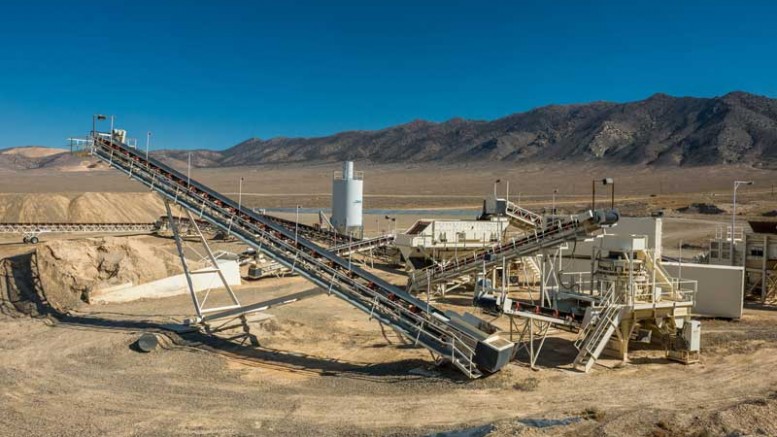Pershing Gold (NASDAQ: PGLC) has published a positive preliminary economic assessment (PEA) on the past-producing Relief Canyon heap-leach gold mine near Reno, Nev., showing it could produce 88,500 oz. gold annually over a 5.8-year mine life.
“This is a milestone for us. We had indicated we would get it out in the second quarter, we’re excited to have done that,” the company’s vice-president of investor relations Jack Perkins says. “It shows the quality and low-cost nature of the project, and the leverage to the gold price for our investors.”
The PEA assesses the economics of two mining scenarios at Relief Canyon, including self-mining — where Pershing would use its workforce and equipment — and contract mining.
While the annual production and mine life would stay the same under both scenarios, the costs and economics would vary.
Start-up costs are US$22 million for self-mining versus US$12.2 million for contract mining.
Initial capital in both cases includes the cost of building leach pads, plant upgrades, and the optimization and relocation of the crusher facility. The US$10-million difference between the two relates to a down payment to buy equipment for self-mining.
Sustaining costs for self-mining are US$15.8 million, or 5% less than for contract mining. Both options cover regular maintenance and leach pad space for future production.
Relief Canyon’s start-up requirements are low because there is a fully built and permitted 12,700-tonne-per-day heap-leach processing facility on-site.
“When we originally purchased the assets, we were able to buy the [three] pits and the processing facility for US$20 million as part of the initial asset acquisition in August 2011. They were bought out of bankruptcy,” Perkins says.
Self-mining cash costs and all-in sustaining costs are US$677 per oz. and US$709 per oz., compared to US$772 per oz. and US$804 per oz. for contract mining.

A drill rig at Pershing Gold’s past-producing Relief Canyon gold project in Nevada. Credit: Pershing Gold.
The self-mining option also has better returns. Using a 5% discount rate and a US$1,250 per oz. gold price, it boasts an after-tax net present value (NPV) of US$138 million and 80% internal rate of return (IRR), with a US$181.6-million post-tax net cash flow.
Using the same parameters, contract mining has a US$121.4-million after-tax NPV and 109% IRR, with a US$157.9-million post-tax net cash flow. Self-mining’s lower operating costs could benefit resource expansion with ongoing exploration, Perkins adds.
The mostly oxide resource of 778,000 measured and indicated oz. gold (from 38.5 million tonnes grading 0.68 gram gold per tonne) and 47,500 inferred oz. (from 5.3 million tonnes at 0.31 gram) remains open in three directions, to the west, east and south.
Pershing will further evaluate the two mining alternatives before making a decision to restart Relief Canyon, Perkins notes. The junior’s board will make an investment decision after receiving state and federal permits for phase one in the third quarter.
Production should start six to nine months after Pershing makes the investment decision and fully finances the project. It is assessing financial options, including equity, debt, royalties and off-take agreements.
Pershing anticipates completing a prefeasibility study by the fourth quarter. The prefeasibility would not delay the production timeline, Perkins says.
Given the project’s low start-up cost, Roth Capital Partners analyst Joe Reagor says that the prefeasibility study is not needed, and the company would pick the self-mining option and build “with an eye on first production in the first half of 2017.” Reagor has reiterated his “buy” rating and US$6.25 target.
Euro Pacific Capital analyst Bhakti Pavani forecasts production as soon as the second quarter of 2017. She says Relief Canyon would process 5 million to 6 million tons (4.5 to 5.4 million tonnes) ore to produce an average 87,582 oz. gold a year. Pavani bumped her US$6 target to US$6.90 per share. She has a “buy” on the stock.
Located 150 km northeast of Reno, Nev., Relief Canyon is in the southern part of the Pershing gold and silver trend, along the Humboldt Range. The trend hosts a number of gold and silver deposits, including Coeur Mining’s (TSX: CDM; NYSE: CDE) Rochester mine, with Pershing aiming to become its newest producer.
Pershing Gold shares closed June 30 at US$4.29, up 1.6%.


Be the first to comment on "Pershing pens positive economics at Relief Canyon"